– Three exoplanets and one candidate –
August 21, 2024, Dr. Gerold Holtkamp
The transit light curve measurements of three confirmed and one unconfirmed exoplanets are presented. These are the exoplanets TrES-3b, HAT-P-18b, TOI-2154b as confirmed and TOI-1251.01 as an unconfirmed exoplanet.
Each of them has peculiarities that make it worthwhile to take a closer look at them. On the one hand, by studying the information that is already available, and on the other hand, by taking part in the ongoing investigations within the scope of one's own abilities. The measurement of transit light curves of exoplanets by amateurs is seen by many professional astronomers as an important contribution to their work (see e.g. the Exoclock project).
A phase of good weather made it possible to record the transit light curves from the end of June to the beginning of August 2024.
TrES-3b
TrES-3b was discovered in 2007. It is an old “acquaintance” as I have already observed it once [1] [2]. Its transit light curve is relatively easy to measure. So it was a good start after a long dry spell of several months with clouds or a full moon or both here in Osnabrück. The good conditions made it possible to determine its radius from the depth of the light curve.
-Click here for the measurement results.-
HAT-P-18b
It was discovered in 2010. Its peculiarity is that its orbital direction is aligned opposite to the direction of rotation of its parent star. This cannot be deduced from the transit light curve, but it has been determined using other methods.
-Click here for the measurement results.-
TOI-2154b
It was discovered in 2023. So far I have only been able to find one publication from which all the data known about this exoplanet comes. There are also hardly any measurements of the transit light curve by other authors. But at least it is already a confirmed exoplanet. Here too, the further development of its research remains exciting.
-Click here for the measurement results.-
TOI-1251.01
It was discovered in 2019. It is a so-called exoplanet candidate, i.e. it is not definitely a planet. There is even a strong suspicion that it is a brown dwarf. This is what happens when you start measuring such possible exoplanets so soon after the discovery itself. You have to remember that you are in an area that has hardly been explored - quite attractive!
-Click here for the measurement results.-
Equipment setup for all measurements
The equipment used for all measurements mentioned in this article was the same:
elescope: Newtonian 250mm aperture, 1200mm focal length
Filter: L (Antlia)
Camera: OHY268M (QHYCCD)
Chiptemperature: -10° C
Gain: 60
Offset: 20
The results
TrES-3b and the parent star TrES-3
Measurement on July 18, 2024
System data [3]
TrES-3 (GSC 03089-00929)
Spectral type: G variable
Apparent brightness: 12.4 mag (V)
Distance: 754 light years
Surface temperature: 5,720 K
Mass: 0.924 times the mass of the Sun
Radius: 0.813 times the radius of the Sun
Constellation: Hercules
TrES-3 b
Discovery: 2007
Distance to parent star: 3.38 million km
orbital period: 1.3 days
Surface temperature: 1,555 K
Mass: 1.9 times the mass of Jupiter
Radius: 90,884 km (radius of Jupiter 69,911 km)
Measurement
The measurement of the transit light curve (85 min. + 120 min. baseline) was carried out under difficult conditions. The moon was 92% illuminated and only 67° away. In addition, because of the midnight twilight, it didn't get completely dark. The height above the horizon decreased from 75° to 53°.
Results
The measured raw data was obtained using the Hops software ExoClock Projekts evaluated. The evaluation showed:
Rp/Rs = 0.1651 ± 0.0028 (expected according to Exoclock: 0.17 ± 0.03)
With the known star radius (see above) and the sun radius (696,340 km), the radius of the planet is Rp = 93,467 +/- 1,585 km. (for the calculation method see [4])
Determining the radius of an exoplanet 754 light-years away, even though you only have one point of light available: This is possible from the city of Osnabrück!
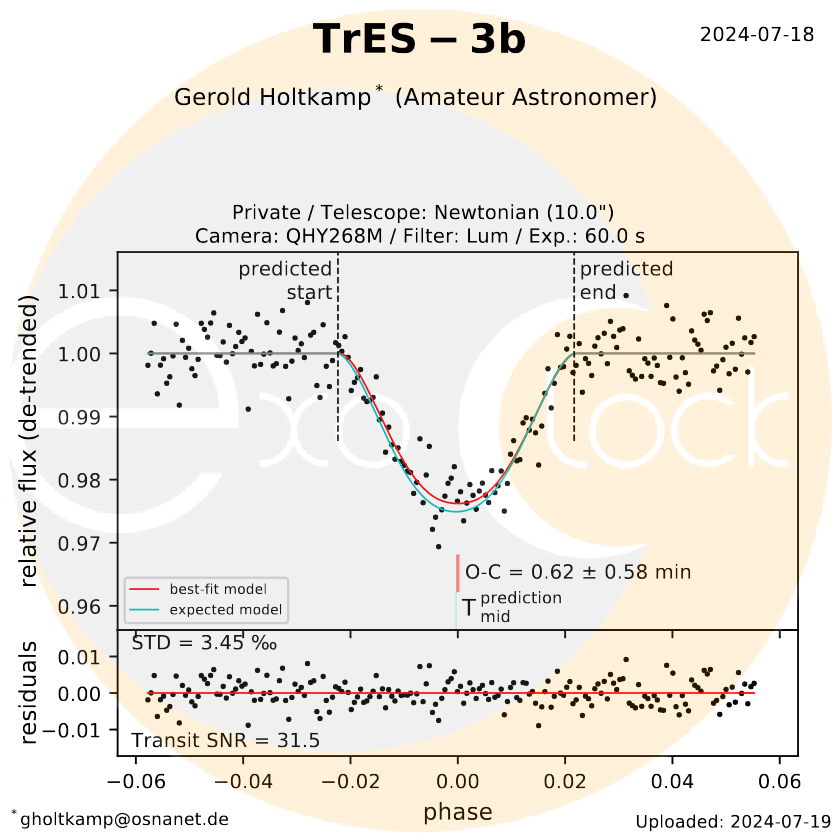

Determining the exact timing of the transit is an important task of the Exoclock project in preparation for ESA's Ariel mission [5].
– Click here to go back to the short description at the beginning –
HAT-P-18b and its parent star HAT-P-18
Measurement on July 28, 2024
System data [6] [7] [8]
HAT-P-18
Spektraltyp: K
Apparent brightness: 12.6 mag (V)
Distance: 525 light years
Surface temperature: 4,790 K
Mass: 0.773 times the mass of the Sun
Radius: 0.740 times the radius of the Sun
Constellation: Hercules
HAT-P-18b
Discovery: 2010
Distance to the parent star: 8.26 million km (large semi-axis)
Orbital period: 5,508 days
Surface temperature: 892 K
Mass: 0.197 times the mass of Jupiter
Radius: 69,561 km (radius of Jupiter 69,911 km)
The planet HAT-P-18b has a peculiarity. It orbits its parent star in the opposite direction to its rotation direction (retrograde) at approximately 132°. [9] Of course, this immediately raises questions about its origins. In our solar system, the orbital directions of all planets and the rotational direction of the sun are the same because they all emerged from the same original gas cloud. HAT-18-P must have gotten to its planet HAT-P-18b by another means. But how?
In addition, there are already measurements that show that, on the one hand, it has an extensive atmosphere, but on the other hand, it also loses around 2% of its mass from the atmosphere every billion years. The first measurements by the JWST in 2022 gave clear indications of water vapor in the - albeit very hot - atmosphere of HAT-P-18b. [10]
Measurement
The moon was 40% illuminated and 119° away. The measurement was essentially problem-free. However, I had probably set the exposure time too close to the limit of overexposure, so that later analysis revealed that every now and then a few pixels were overexposed, but this obviously didn't harm the result (because there were only a few). Actually, the exposure should have decreased somewhat over the approximately 4.5 hour measurement period because the height of the observation object decreased from 67° at the beginning to 27° at the end. But if, for example, the seeing got better during this time, higher exposures may have occurred. An evaluation with the HOPS software from the Exoclock project was not possible because the software is very sensitive to overexposed pixels in the individual images.
Results
The measured raw data were evaluated with MuniWin and the light curve obtained was sent to Exoplanet Transit Database (ETD) There, a possible trend in the data is eliminated, a compensation curve is calculated and values are given for the transit depth, duration, start and end.
The evaluation showed:
Transit depth = 0.0285 ± 0.0008
This results in Rp/Rs = 0.169 +/-0.028
With the known star radius (see above) and the sun radius (696,340 km), the radius of the planet is Rp = 90,968+/- 15,072 km (for the calculation method see [4]). This means that the measured value deviates significantly upwards from the specified literature value, even within the error limits.
What is interesting, however, is that when evaluated in ETD, almost all measurements of the transit depth by other authors deviate upwards from the default value, i.e. the planet radius is also measured larger than expected in ETD. [11]
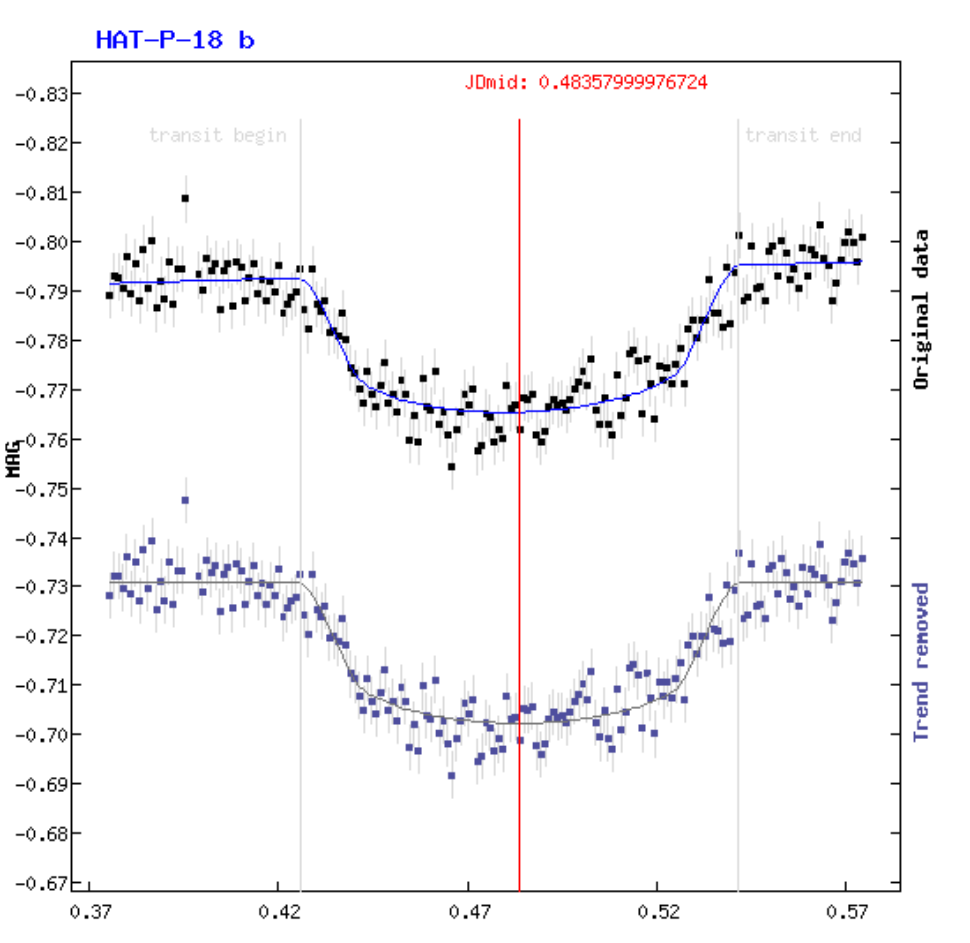
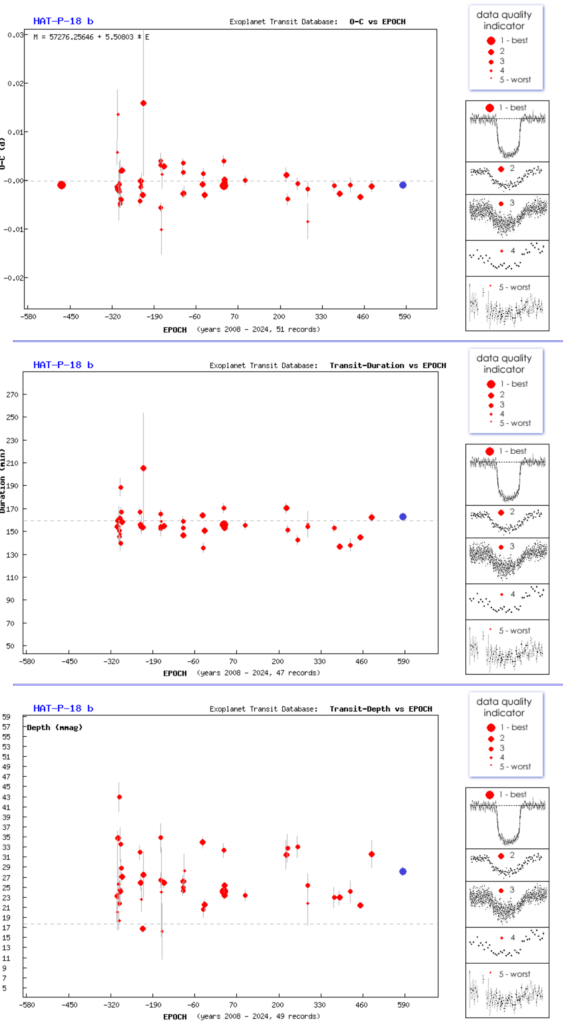
– Click here to go back to the short description at the beginning – –
TOI-2154b and its parent star TOI-2154
Measurement on July 29, 2024
System data[17][18]
TOI-2154
Spectral Type: F
Apparent brightness: 11.1 mag (V)
Distance: 965 light years
Surface temperature: 6,280 K
Mass: 1.233 times the mass of the Sun
Radius: 1.396 times the radius of the Sun
Constellation: Cepheus
TOI-2154b
Discovery: 2023
Distance to the parent star: 7.67 million km (large semi-axis)
Orbital period: 3.82 days
Surface temperature: 1,580 K
Mass: 0.92 times the mass of Jupiter
Radius: 101,580 km (radius of Jupiter 69,911 km)
The very recent discovery date of the exoplanet means that there are hardly any measurements or publications on the system. However, it is listed in [17] as a confirmed exoplanet. The above-mentioned system data all come from a single previously available publication [19].
Measurement
At the beginning of the 4.5 hour measurement it was not yet completely dark. The moon was not disturbing for long with 30% illumination and 60° distance. The brightness of TOI-2154 at 10.835 mag (short exposure time) and the expected relatively weak attenuation of about 0.011 mag made the measurement difficult.
Results
The measured raw data was evaluated again with MuniWin and the light curve obtained was sent to the Exoplanet Transit Database (ETD).
The transit duration was 162.6 minutes (167 minutes exoclock, 151 minutes transit finder) and the transit depth was 0.0132 +/-0.0007 (0.0123 ETD, 0.0113 exoclock, 0.0101 transit finder). The planetary radius can be determined again using the transit depth: Rp = 111,800 +/-25,719 km (for the calculation method see [4]). Admittedly, this value still needs improvement, but it is within the error limits.
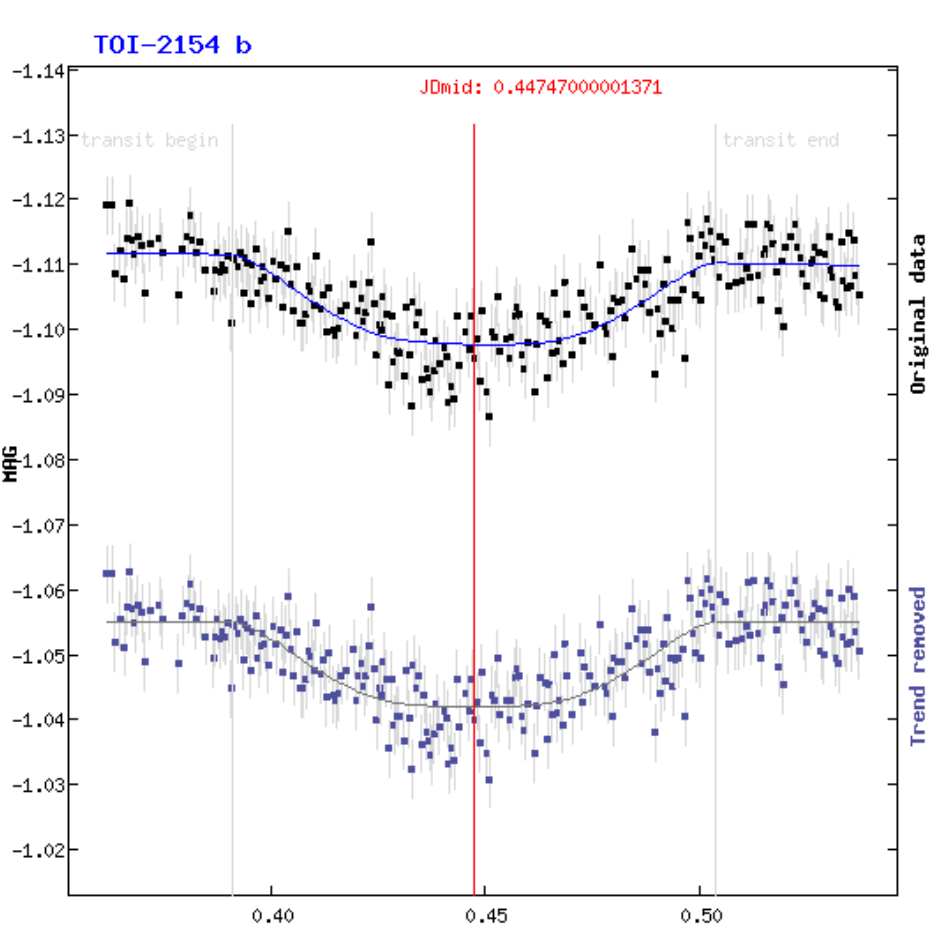
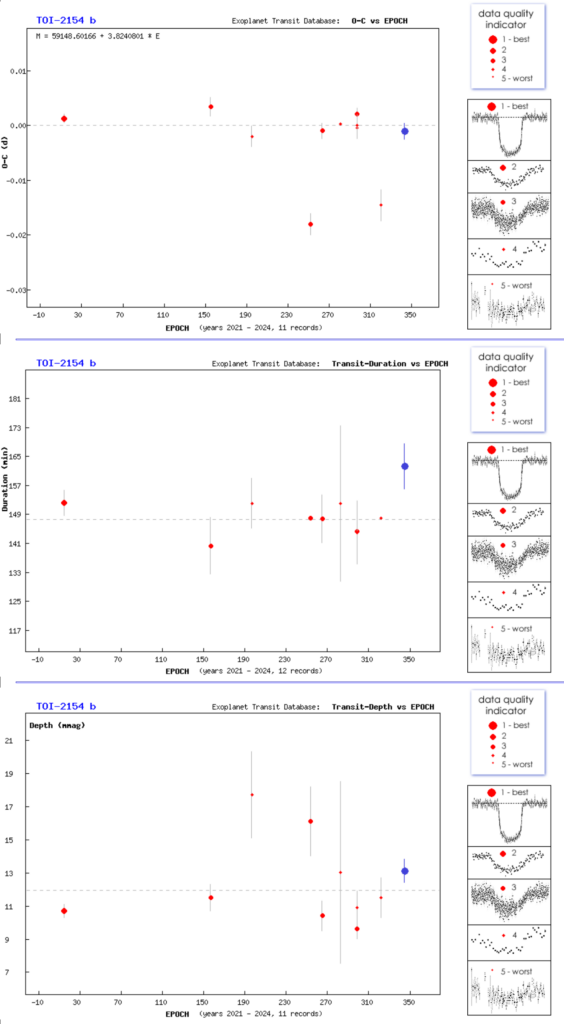
– Click here to go back to the short description at the beginning –. –
TOI-1251.01 and its parent star TOI-1251
Measurement on July 24, 2024
System data [12] [13]
TOI-1251
Spectral type: unknown
Apparent brightness: 11.5mag (V)
Distance: 607 light years
Surface temperature: 5,769 K
Mass: 1.057 times the mass of the Sun
Radius: 0.9860 times the radius of the Sun
Constellation: Dragon
TOI-1251.01 (candidate planet)
TIC 233120979.01
Discovery: 2019
Distance to parent star: unknown
Orbital period: 5.963 days
Surface temperature: unknown
Mass: 96 times the mass of Jupiter (? see below)
Radius: 62,850 km (radius of Jupiter 69,911 km)
TOI-1251.01 is a so-called exoplanet candidate, i.e. a light curve was measured by TESS, but confirmation using another method is required for a confirmed exoplanet, e.g. measurement of the surface temperature and/or mass. The discussion is obviously still ongoing here. While an exoplanet was still assumed in 2021, measurement results were published in 2023 that indicate a brown dwarf because TOI-1251.01 was measured to have a mass of 96 times Jupiter [14] [15] [16]. However, in a table in the same publication the term “Radius of planet in stellar radii” is mentioned again. It remains to be seen how the discussion will continue.
So it is exciting, even for an amateur, to move into “uncharted” astronomical territory. If TOI-1251.01 is defined as a brown dwarf, it will have to be removed from my “exoplanet collection”.
Measurement
The moon was 83% illuminated and was 90° away. The total measurement duration (transit and baseline) was five hours. The height above the horizon changed from 79° to 53°. The humidity was high.
Results
The measured raw data was evaluated with MuniWin and the light curve obtained was sent to the Exoplanet Transit Database (ETD). A possible trend in the data was again eliminated, a compensation curve was calculated and values for the transit depth, duration, start and end were given.
However, there are no light curves from other authors for ETD, so the comparison graphics for transit center, duration and depth cannot be shown here.
The measured transit depth was 0.0129 +/-0.0004 mag (0.011 mag Transitfinder (Link)). The transit time was 184.2 +/-2.1 minutes (177 minutes Transitfinder). The middle of the transit is given as 23:40:58 UTC (23:39 UTC Transitfinder) on July 24, 2024.
If you know the radius of the parent star, you can calculate the radius of the object (exoplanet or brown dwarf) from the measured transit depth (see [4] for the calculation method):
Radius(TOI-1251.01) = SQR(0.0129) * Radius(TOI-1251) = 77,982 +/- 13,732 km (radius of Jupiter 69,911 km) According to the above source, the value would be too large. However, the values of Transitfinder (70,355 km) and Exofop (75,241 km) also vary [13]. All that remains is to wait for further measurements.
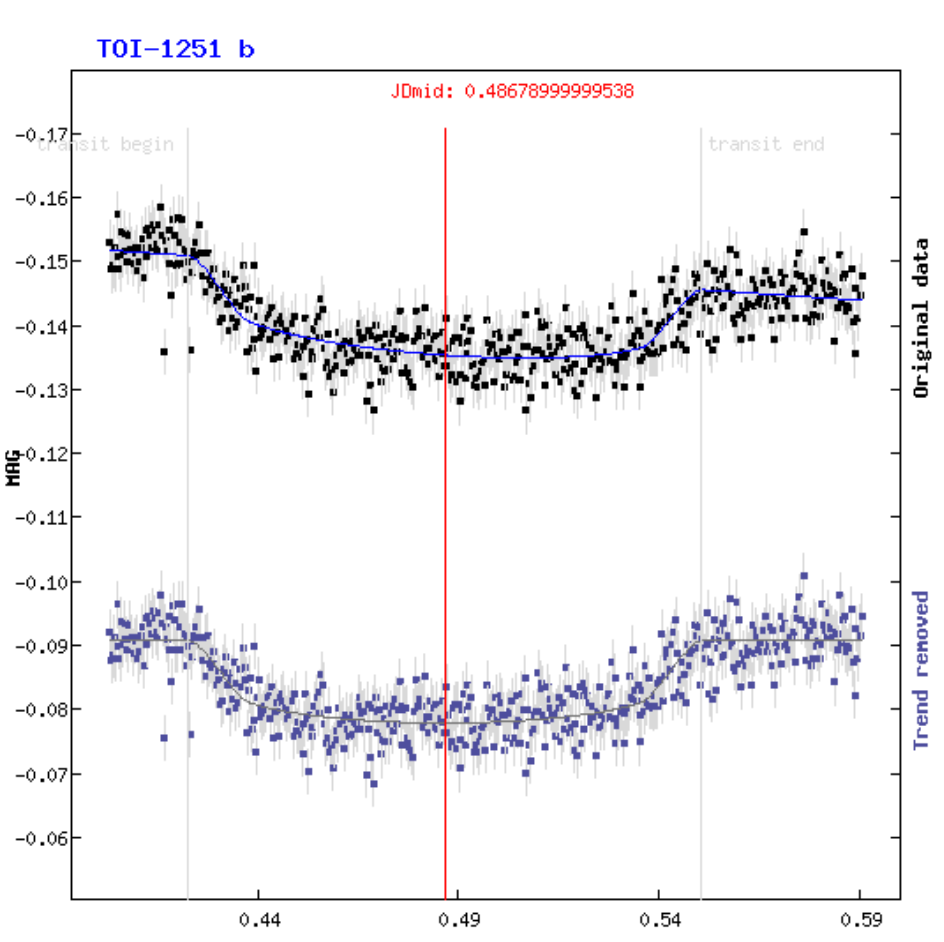
– Click here to go back to the short description at the beginning –. –
[1] https://kosmos-os.de/messung-der-transitkurve-des-exoplaneten-tres-3-b-am-27-5-2023/
[2] https://www.exoclock.space/database/observations/TrES-3b_6543_2023-05-27_Gerold_1561_Lum/
[3] https://exoplanetarchive.ipac.caltech.edu/overview/TrES-3%20b
[5] https://arielmission.space/
[6] https://exoplanetarchive.ipac.caltech.edu/overview/HAT-P-18
[7] https://en.wikipedia.org/wiki/HAT-P-18
[8] https://science.nasa.gov/exoplanet-catalog/hat-p-18-b/
[9] M. Esposito et al. Astronomy&Astrophysics 564, L13 (2014) https://www.aanda.org/articles/aa/pdf/2014/04/aa23735-14.pdf
[10] Guangwei Fu et al. The Astrophysical Journal Letters, 940:L35 (8pp), 2022 December 1 https://iopscience.iop.org/article/10.3847/2041-8213/ac9977/pdf
[11] https://var.astro.cz/en/Exoplanets/387
[12] https://exoplanetarchive.ipac.caltech.edu/overview/TOI-1251
[13] https://exofop.ipac.caltech.edu/tess/target.php?id=233120979
[14] Howell, S. B., et al. 2021, Astrophysical Journal 161, 164 https://iopscience.iop.org/article/10.3847/1538-3881/abdec6/pdf
[15] Jia-Qi Wang et al 2024 Res. Astron. Astrophys. 24 035012
https://arxiv.org/pdf/2310.12458
[16] https://de.wikipedia.org/wiki/Brauner_Zwerg
[17] https://exoplanetarchive.ipac.caltech.edu/overview/TOI-2154b
[18] https://science.nasa.gov/exoplanet-catalog/toi-2154-b/
[19] Monthly Notices of the Royal Astronomical Society, Volume 521, Issue 2, May 2023, Pages 2765–2785, https://doi.org/10.1093/mnras/stad595